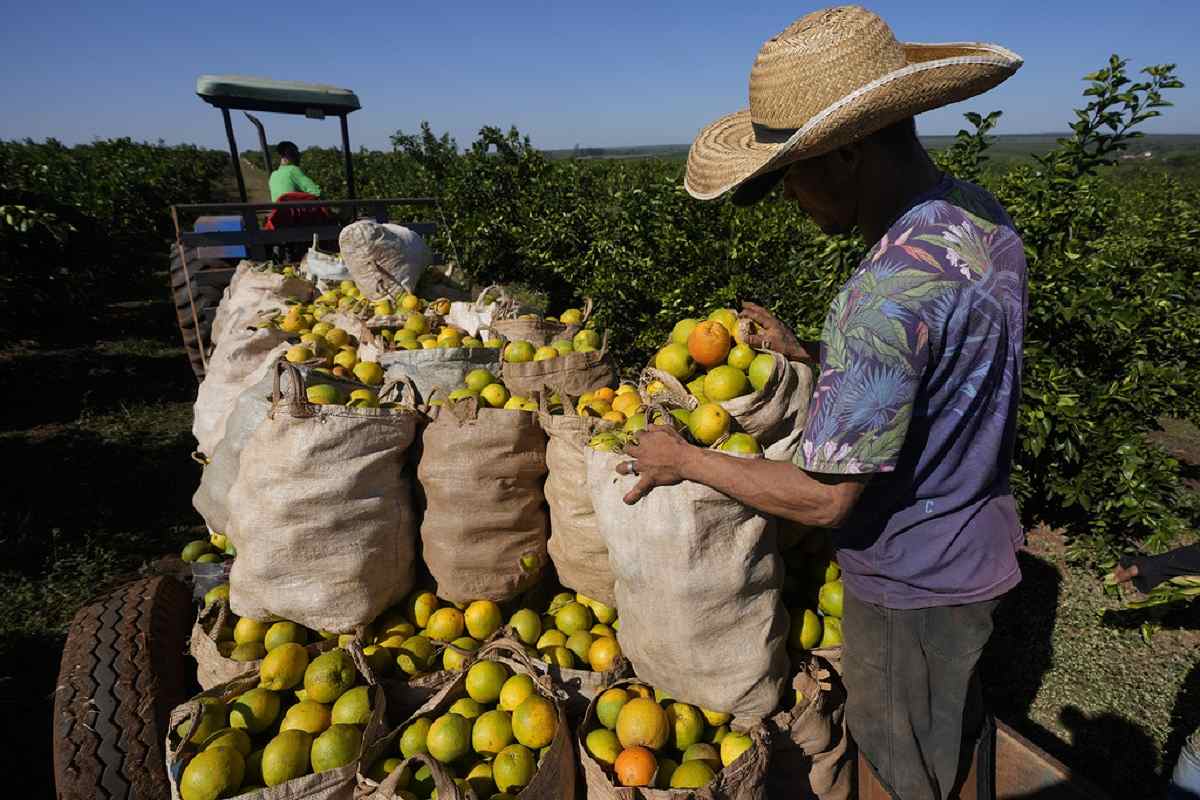High Orange Juice Prices May Be on the Table for a While Due to Disease and Extreme Weather

A worker harvests oranges on a farm in Mogi Guacu, Brazil, June 13, 2024.
14:06 JST, June 15, 2024
MOGI GUACU, Brazil (AP) — Orange juice prices have always been volatile, falling when bumper harvests create an oversupply of oranges and rising when frost or a hurricane knocks out fruit trees.
But the record-high prices the world is seeing for OJ right now may be on the table for a while, since the diseases and extreme weather ravaging orange groves in some top-producing countries aren’t easily resolved problems.
This year’s harvest in Brazil, the world’s largest exporter of orange juice, is likely to be the worst in 36 years due to flooding and drought, according to a forecast by Fundecitrus, a citrus growers’ organization in Sao Paulo state.
The concern isn’t just that the price of juice is going up. The concern is not having the juice, Oscar Simonetti, an orange farmer in Mogi Guacu, Brazil, said.
In the U.S., Florida’s already diminished orange production fell 62% in the 2022-2023 season after Hurricane Ian further battered a crop that was struggling due to an invasive pest. Drought also cut Spain’s orange production last year.
Scarce supplies have sent prices soaring. In the U.S., a 12-ounce can of frozen orange juice concentrate cost an average of $4.27 in April, 42% more than during the same month a year earlier, according to government figures.
In the United Kingdom, where the British Fruit Juice Association says supplies are at 50-year lows, the price of fresh orange juice rose 25% over the past year, according to consumer research company Nielsen.
Those price increases are turning off inflation-weary consumers. Orange juice consumption has fallen 15% to 25% in major global markets — including the U.S. and the European Union — over the last year, according to Rabobank, a Dutch bank that focuses on food and agriculture.
Jonna Parker, a principal for fresh food client insights at market research company Circana, said consumers are increasingly getting their morning fruit intake from energy drinks, smoothies and other beverages besides orange juice.
The price gets high and people consider other alternatives, she said.
Global orange juice consumption was already declining before the current price hikes due to competition from other drinks and public concern about the amount of sugar in fruit juices. If that trend continues, it should help balance supply with demand and keep prices from rising much further, Rabobank said. But it expects limited supplies will keep prices elevated for some time.
In some markets, orange juice is disappearing from shelves altogether.
Late last year, McDonald’s in Australia removed orange juice from its menu in favor of an “orange fruit drink” that contains 35% orange juice. The company cited short supplies.
Tokyo-based Morinaga Milk Industry Co. expects to stop shipping its Sunkist brand orange juice – which uses juice from Brazil – by the end of June because of low juice supplies from Brazil, a company spokeswoman said. In April 2023, Megmilk Snow Brand Co., based in the northern Japanese city of Sapporo, stopped shipments of 1-liter (about a quart) and 450-milliliter (15.2-ounce) packs of orange juice, which it sells under an agreement with Dole. Sales haven’t yet resumed.
Some companies are considering using alternatives to oranges in their products. Coldpress, a British juice company, introduced a mandarin juice product in February, citing the high price of regular juicing oranges.
But others are tight-lipped about their plans. Several major orange juice makers – including Dole, Tropicana, Florida’s Natural, Uncle Matt’s and Coca-Cola, which makes the Simply and Minute Maid brands – declined to comment or failed to respond to inquires from The Associated Press.
The roots of the current supply troubles stretch back decades. In 2005, an invasive bug called the Asian citrus psyllid arrived in Florida, injecting bacteria from its saliva into the state’s orange trees. The bacteria slowly kills the tree by destroying its root systems. There’s no known cure once a tree is infected.
The impact has been devastating. In 2004, before the disease – called citrus greening – hit Florida, the state produced 200 million boxes of oranges. This year, it will produce less than 20 million.
Michael Rogers, a professor of entomology and the director of the University of Florida’s Citrus Research and Education Center, said no type of orange tree is totally resistant to greening, but scientists have been trying to breed trees that are more tolerant of it.
Citrus greening arrived in Brazil around the same time as Florida, but it has progressed more slowly there because Brazil has much larger orange groves. Bugs spread the disease by flying from tree to tree, Rogers said.
Still, the disease is spreading. Fundecitrus estimates that 38% of Brazil’s orange trees had citrus greening in 2023. Simonetti, the orange farmer, estimates that 20% of his production is affected by greening. Oranges on affected trees don’t ripen properly and fall off early, affecting the quality of their juice, he said.
Shifting production to other locations isn’t necessarily an option. California grows oranges, for example, and the citrus psyllid doesn’t fare as well in the state’s climate. But California also doesn’t get the rainfall needed for juicing oranges; its oranges are usually sold for eating, Rogers said.
Another issue impacting orange harvests is extreme weather, which is becoming more common as the world warms due to climate change.
Last year, nine heat waves swept across Brazil, resulting in lower output and poorer fruit quality. This year, the impacts of El Niño have been particularly dramatic, with a historic drought in the Amazon and devastating floods in the southern state of Rio Grande do Sul.
The temperatures are high during the day. At night the temperature drops. The plant can’t stand this temperature difference, Simonetti said.
Brazil’s 2024-2025 harvest is expected to yield 232 million boxes of oranges, down 24% from the prior year.
We have never seen a harvest like this, Vinícius Trombin, the coordinator of Fundecitrus’ crop estimates survey, said.
To make up for the anticipated smaller yield, some producers are considering blending oranges with tangerines to make juice, Trombin said. But he’s skeptical.
The consumer wants an orange juice made up 100% out of oranges, he said.
Parker, of Circana, isn’t so sure. She thinks blends with other fruits might help hold down costs and revive consumer interest in orange juice.
The idea of multiple flavors is very popular and is a way to stand out, she said. “You’ve got to keep people engaged. Once you lose that interest, it’s really hard to get people back.”
"News Services" POPULAR ARTICLE
-

American Playwright Jeremy O. Harris Arrested in Japan on Alleged Drug Smuggling
-

Japan’s Nikkei Stock Average as JGB Yields, Yen Rise on Rate-Hike Bets
-

Japan’s Nikkei Stock Average Licks Wounds after Selloff Sparked by BOJ Hike Bets (UPDATE 1)
-

Japan’s Nikkei Stock Average Buoyed by Stable Yen; SoftBank’s Slide Caps Gains (UPDATE 1)
-

Japanese Bond Yields Zoom, Stocks Slide as Rate Hike Looms
JN ACCESS RANKING
-

Keidanren Chairman Yoshinobu Tsutsui Visits Kashiwazaki-Kariwa Nuclear Power Plant; Inspects New Emergency Safety System
-

Imports of Rare Earths from China Facing Delays, May Be Caused by Deterioration of Japan-China Relations
-

Tokyo Economic Security Forum to Hold Inaugural Meeting Amid Tense Global Environment
-

University of Tokyo Professor Discusses Japanese Economic Security in Interview Ahead of Forum
-

Japan Pulls out of Vietnam Nuclear Project, Complicating Hanoi’s Power Plans


























